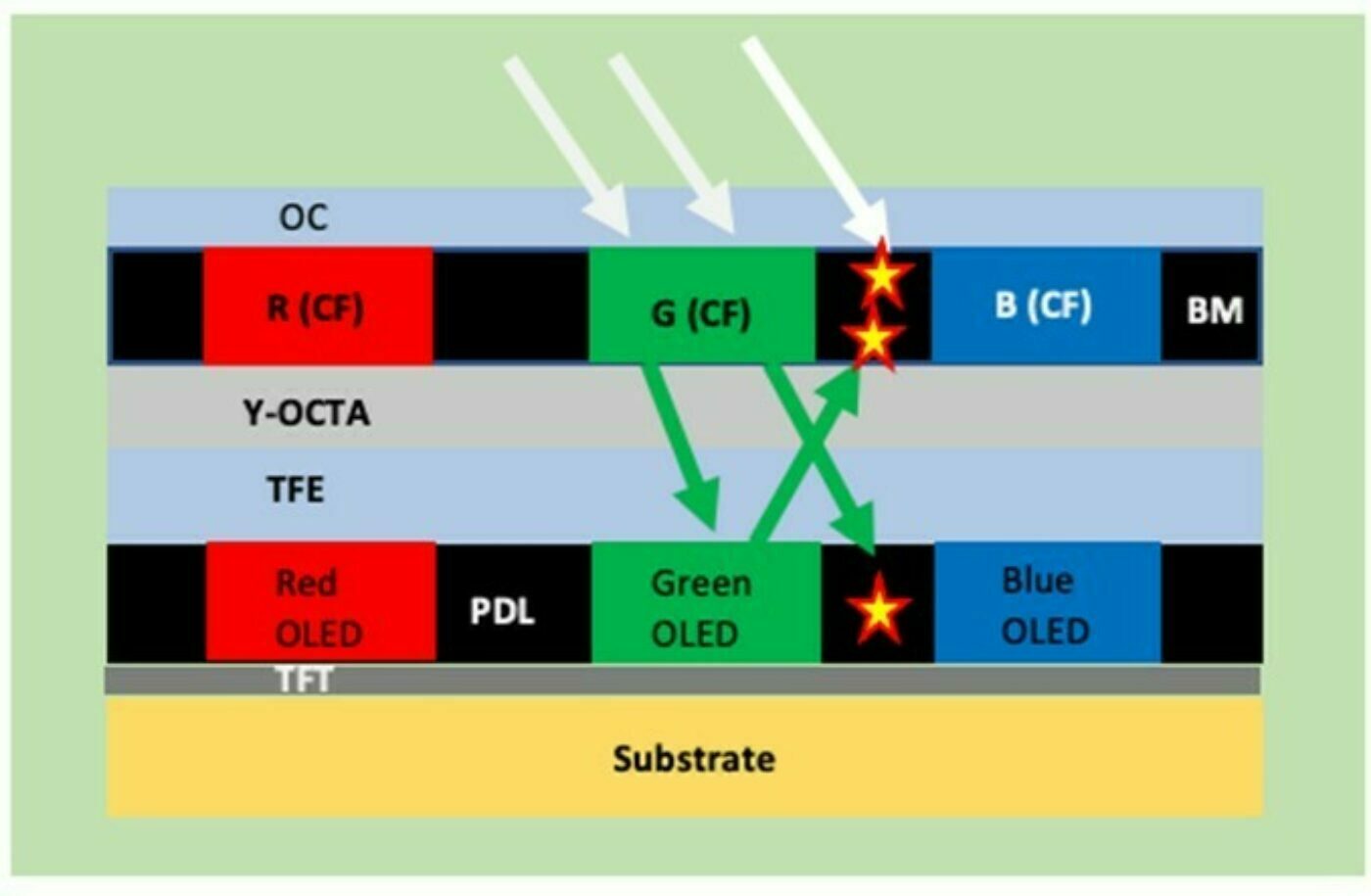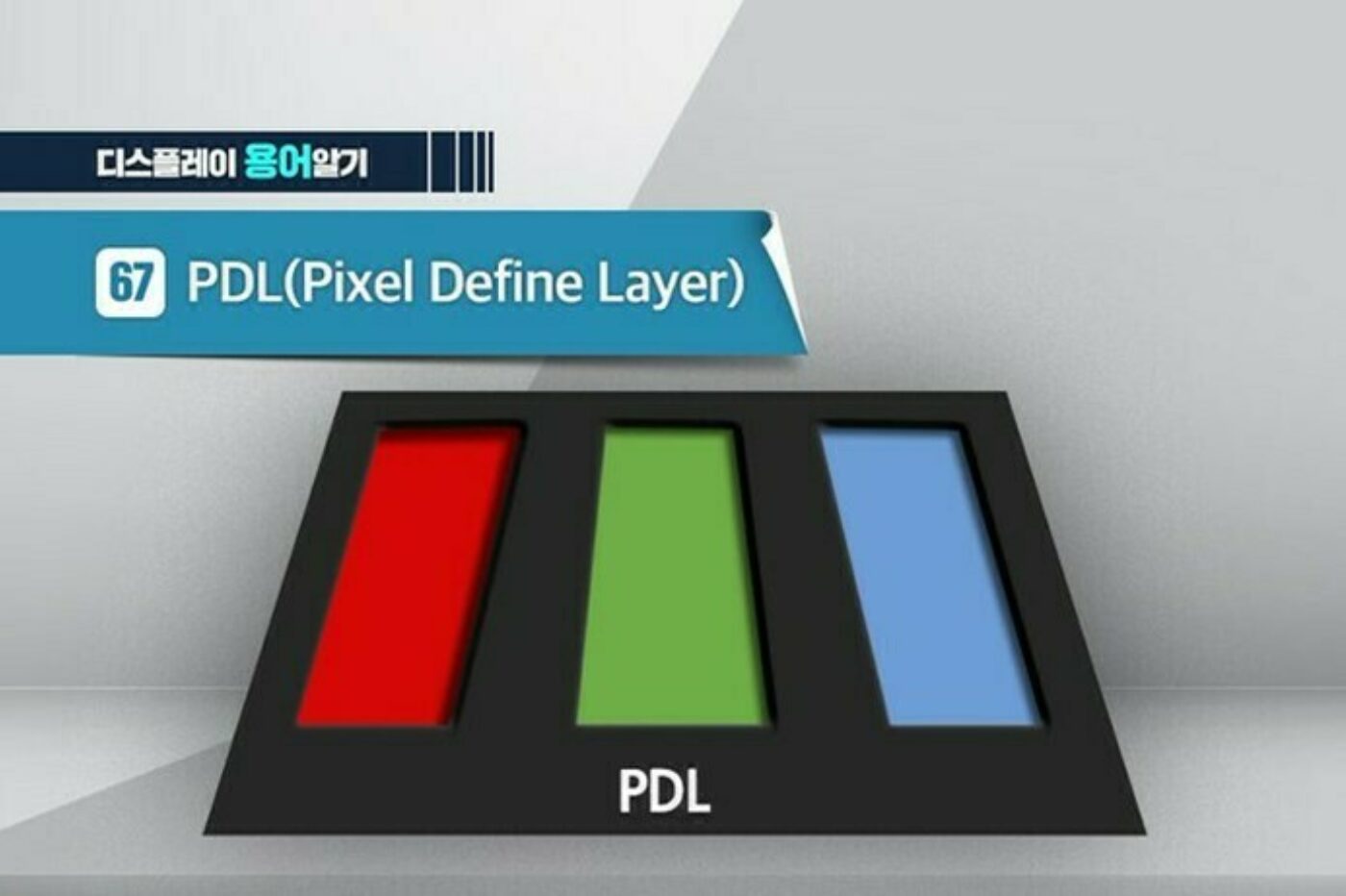国内お問い合わせ窓口
info@displaysupplychain.co.jp
FOR IMMEDIATE RELEASE: 03/29/2021
New Insights on How SDC Will Introduce Polarizer-Free OLEDs, Significant Increase in Brightness Also Expected
Ross Young, Founder and CEOAustin, TX USA -
Korea’s ETNews published a story last week detailing Samsung Display’s efforts to introduce polarizer-less displays, which they called POL-LESS OLEDs. This structure has been called On Cell Polarizers (OCP) and Color On Encapsulation (COE) in the past. The first AMOLEDs without polarizers are now expected in the Galaxy Fold 3 in Q3’21.
The circular polarizer in AMOLEDs is used to reduce reflection. While it does a great job reducing reflection, it increases the display thickness by 50µm to 100µm and reduces brightness. Eliminating circular polarizers and patterning a thin color filter structure of <5µm to replace this function will significantly reduce the display thickness by around 20% in foldable OLEDs, increase brightness and give the panel suppliers greater control of their cost structure at the expense of their existing polarizer suppliers Sumitomo Chemical and Nitto, depending on the type of display produced.
We have learned that there are three key technologies involved in replacing the polarizer:
- A black rather than transparent Pixel Definition Layer (PDL)/bank layer. This was previously not disclosed, so is something new which could play an important role in closing reflectivity performance with polarizers;
- A newly added color filter;
- A newly added black matrix.
The new structure is shown below:
Samsung Display’s POL-LESS AMOLED Structure
The PDL is the last mask in the TFT process below the OLED layers. It is a relatively thick layer and serves to define each sub-pixel so that the OLED colors do not interfere with each other. Toray is believed to have the highest market share in PDL materials, and their material is typically transparent. Neolux has developed a black PDL that SDC is evaluating. It will help improve the reflectivity ratio as it will absorb any light that gets through the color filter, which is not absorbed or reflected by the emissive layers. It was previously thought that the reflectivity performance with OCP/COE may still require the lamination of a single anti-reflective film, but perhaps with a black PDL it won’t be needed.
The color filter and black matrix patterned on top of the Y-OCTA layers will be the primary way reflection is improved. However, this does add significant complexity to the manufacturing process. We estimate an additional five masks are required to add the BM, RGB color filter and OC layers. We believe it will require seven additional litho tools for 30K substrates/month due to the slower throughput associated with these steps resulting from the low-temperature requirement since they need to protect the underlying layers. Rather than hardening the photoresist for the BM, CF and OC materials with a hard bake, they are hardened by photolithography which requires a higher dose and slower throughput. This would lead to a heavy capital expenditure in litho tools which are one of the most expensive tools in the backplane fab and could be a catalyst for Canon, Nikon, SCREEN, TEL, etc. Finally, with the increased number of processing steps, there is always a risk of lower yield.
We have heard that the current prototypes made using the POL-LESS process have increased brightness by 20% to 30% and combining POL-LESS and LTPO will reduce power consumption by more than 30%.
Challenges that remain to be overcome to commercialize this new process profitably include viewing angles and yields. However, we would expect them to be overcome by the technology and manufacturing leader. In fact, it is expected that this process will be used on the Galaxy Fold 3 and may be used on rollable and flexible OLEDs as well as yields, performance and costs dictate. It also represents another way for Samsung Display to differentiate itself from the competition. Of course, all other mobile OLED suppliers are also believed to be working on this process.
In terms of the polarizer suppliers at risk, Nitto Denko is SDC’s current choice for foldable AMOLEDs and is at the most immediate risk although volumes are still relatively small on SDC’s foldable products. However, if this process was to be implemented on other flexible displays over time, Sumitomo Chemical is likely more at risk as they are the dominant supplier for SDC’s flexible OLEDs for both Samsung and Apple. We would not expect to see it on rigid OLEDs where Sumitomo is also SDC’s primary supplier.
Other Developments Expected on the Galaxy Fold 3
The ETNews story also touched on other developments coming on the Galaxy Fold 3. These include pen input and an under panel camera. In order for the display to withstand the impact and pressure from the S-Pen, the ultra-thin glass thickness will be increased. The reason the Galaxy Fold 2 did not have an S-Pen was that it reportedly failed the pen drop tests. However, it seems they have a better solution now. Perhaps we will learn more about this new UTG material from SCHOTT’s talk at the SID/DSCC Business Conference.
ETNews also claimed that SDC would be incorporating an under panel camera on the foldable display in the Z Fold 3. Samsung LSI will be developing the image sensor. To enable the camera to capture the desired images without interference from the materials above it in the display, SDC has developed a special display design. It is believed that the resolution, aperture ratio, pixel placement, etc., will change in the area above the camera to ensure the photos look as desired. An image correction algorithm is also going to be implemented, as will a higher resolution camera to compensate for any resolution lost. If successfully commercialized, Samsung and SDC will be the first brand and panel supplier to implement UPCs on a phone with a flexible or foldable display. The first UPC AMOLED phones used rigid OLEDs, which are easier to implement due to the lack of a yellow polyimide substrate. However, they did not sell well.
About Counterpoint
https://www.displaysupplychain.co.jp/about
[一般のお客様:本記事の出典調査レポートのお引き合い]
上記「国内お問い合わせ窓口」にて承ります。会社名・部署名・お名前、および対象レポート名またはブログタイトルをお書き添えの上、メール送信をお願い申し上げます。和文概要資料、商品サンプル、国内販売価格を返信させていただきます。
[報道関係者様:本記事の日本語解説&データ入手のご要望]
上記「国内お問い合わせ窓口」にて承ります。媒体名・お名前・ご要望内容、および必要回答日時をお書き添えの上、メール送信をお願い申し上げます。記者様の締切時刻までに、国内アナリストが最大限・迅速にサポートさせていただきます。

